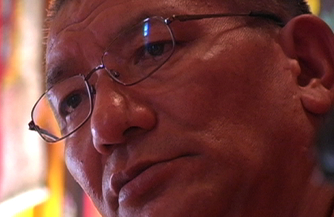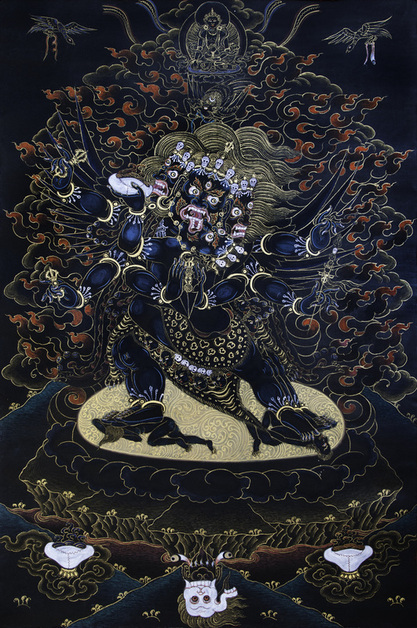|
Dudjom Rinpoche
Video Media Print Media Dalai Lama Penor Rinpoche Video Media Gyatrul Rinpoche Video Media Print Media Yangthang Rinpoche Video Media Print Media Khenpo Jigphun Video Media Tulku Sang Ngag Video Media Khenchen Namdröl Video Media Penam Rinpoche Lobpön Nikula Kusum Lingpa Dodrubchen Rinpoche Chagdud Rinpoche Drugchen Rinpoche B. Alan Wallace |
A Letter about Kathog Getse Rinpoche, by His Holiness the Dalai Lama Kathog Getse Rinpoche, like his previous incarnations, illuminates the teachings of the Early Translation School (Nyingma), the first Buddhist doctrine of Tibet, and embodies a great living legacy of the Buddhist teachings. Furthermore, some in his series of incarnations have a connection with the past incarnations of His Holiness the Dalai Lama. For example, when Kathog Rigdzin Tsewan Norbu went to Lhasa, the (Seventh) Dalai Lama, Kelsang Gyatso, held him in high regard and asked him to reverse, through ritual, the Mongolian army in northern Tibet, which he did. The Seventh Dalai Lama, greatly pleased, offered him a handsome reward. The true reincarnation of Kathog Rigdzin Tsewang Norbu was the First Kathog Getse, Mahapandita Gyurmed Tsewang Chogdrub. When he came to Lhasa on pilgrimage he met the Eighth Dalai Lama, Jamphel Gyatso, and the two of them immediately began exchanging teachings. This association became an inexhaustible offering that pleased all the buddhas, and great mutual respect developed between them. Later, the Third Kathog Getse, Gyurmed Tenpa Namgyal, came to Lhasa to meet the Thirteenth Dalai Lama, Thupten Gyatso. He was received with joy and they developed a good relationship. His direct reincarnation, the Fourth Kathog Getse, Gyurmed Tenpa Gyaltsen, through the power of his previous excellent aspirations and karma, was able to safely arrive in India as a refugee. He and I have connected as student and teacher. With unshakeable pure intentions, faith, and pure vows he has engaged diligently in the trainings of both sutra and mantra. For the sake of students in foreign countries and here in Asia, he is increasingly benefitting the Buddhist doctrine and sentient beings, and I praise and rejoice in his activity! May he have longevity! Written by the Dalai Lama, a bhikshu of Shakyamuni, on the 18th day of the 4th Tibetan month, in the Fire Pig year of the 17th Rabjung; according to the Gregorian calendar, June 4th, 2007. (This translation provided courtesy of Light of Berotsana; translated by Lama Chöying Namgyal.) |
|
|
Vajrakilaya Pudri Regphung (VKGR1) [R]
Getse Rinpoche teaches on the practice of Vajrakilaya in personal retreat according to the instruction manual of H.H. Dudjom Rinpoche, Jigdrel Yeshe Dorje, entitled Fulfillment of All Wishes: The Attainment of Siddhi, Instructions for Practice of the Approach of Vajrakilaya, the Lineage known as Pudri Regphung, the Razor that Destroys at a Touch. Tashi Chöling Retreat Center, Ashland, Oregon, August 2011. Translated by Shashi Reitz. Restricted (4 DVDs/9 hrs, 45 min) $50.00 plus shipping cost |
|
|
The Four Dzogchen Samayas (VKGR3) [R]
Getse Rinpoche teaches on the four Dzogchen samayas during the annual Yeshe Lama retreat. Emphasis is placed on the first of the four samayas. Tashi Chöling Retreat Center, Ashland, Oregon, August 2011. Shashi Reitz translates. Restricted (1 DVD/49 min) $16.00 plus shipping cost |
|
|
Khordei Rushen: Discerning Samsara and Enlightenment (VKGR4) [R]
Two brief teachings by Getse Rinpoche given at the beginning of the annual Tashi Chöling Yeshe Lama retreat on the practice of khordei rushen, distinguishing samsara and enlightenment. Tashi Chöling Retreat Center, Ashland, Oregon, August, 2011. Shashi Reitz translates. Restricted (1 DVD/1 hr/8 min) $20.00 plus shipping cost |
|
|
Establishing the View of Trekchöd: Nonexistence (VKGR5) [R]
Getse Rinpoche speaks on the trekchöd view: understanding it, realizing it, applying it, and the consequent benefits. Of the four aspects affirmed by Longchen Rabjam as necessary in maintaining the dzogchen view, Rinpoche emphasizes the first. Tashi Chöling Retreat Center, Ashland, Oregon, August, 2011. Shashi Reitz translates. Restricted (1 DVD/43 min) $16.00 plus shipping cost |
|
|
Yeshe Lama 2011, Day 4: Questions and Answers (VKGR6) [R]
Getse Rinpoche invites students to ask questions on mantra practice and dzogchen teachings, promising to answer them if he can. Topics raised and Rinpoche’s responses include: clinging to one's practice, attachment to virtuous activities, the habit of thinking with bodhichitta, distinguishing alaya and rigpa, the difficulty of liberating thoughts. Tashi Chöling Retreat Center, Ashland, Oregon, August, 2011. Shashi Reitz translates. Restricted (1 DVD/60 min) $16.00 plus shipping cost |
|
|
Freeing Oneself From the Four Attachments (VKGR8) [R]
Getse Rinpoche provides a brief commentary on the pith instructions of Drakpa Gyaltsen (1147-1216), the third of the Five Superiors of the Sakya tradition: If one has attachment to this life, one is not a practitioner. If one has attachment to samsara, one does not have renunciation. If one has attachment to self cherishing, one does not have bodhichitta. If one has attachment to duality, one does not have the view. Recorded at Tashi Chöling Retreat Center, Ashland, Oregon, July 22, 2012. Shashi Reitz translates. (1 DVD/1 hr, 24 min) $14.00 plus shipping cost |

